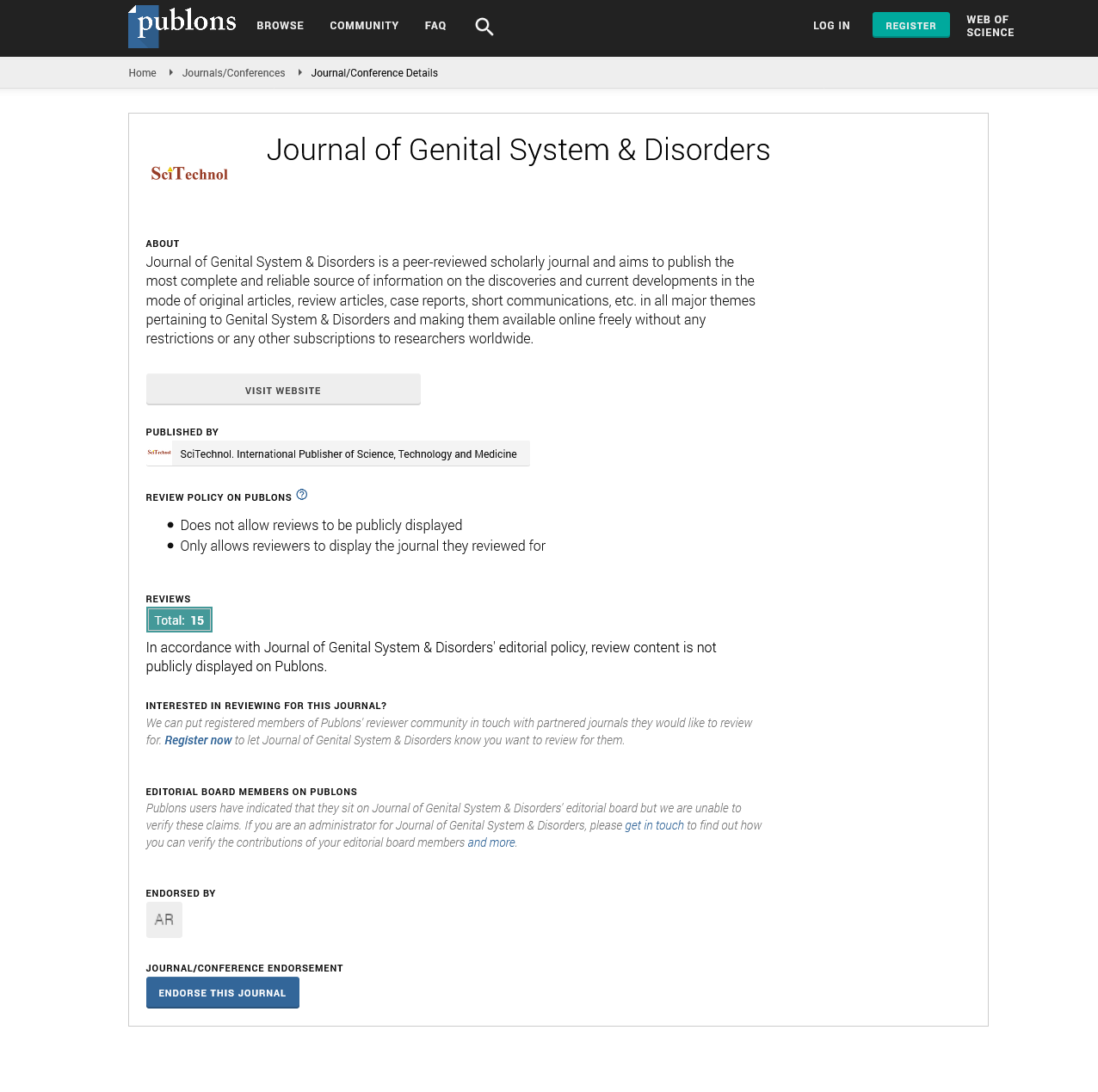Perspective, J Genit Syst Disord Vol: 12 Issue: 2
Pediatric Gynecology: Gynecological Conditions in Children and Adolescents
Yuan Du*
1Department of Pediatrics and Adolescent Gynecology, Zhejiang University School of Medicine, Hangzhou, China
*Corresponding Author: Yuan Du,
Department of Pediatrics and Adolescent
Gynecology, Zhejiang University School of Medicine, Hangzhou, China
E-mail: du.yuyan90k@uni.edu.cn
Received date: 22 May, 2023, Manuscript No. JGSD-23-107305;
Editor assigned date: 24 May, 2023, PreQC No. JGSD-23-107305 (PQ);
Reviewed date: 08 June, 2023, QC No. JGSD-23-107305;
Revised date: 16 June, 2023, Manuscript No. JGSD-23-107305 (R);
Published date: 26 June, 2023 DOI: 10.4172/2325-9728.1000280
Citation: Du Y (2023) Pediatric Gynecology: Gynecological Conditions in Children and Adolescents. J Genit Syst Disord 2023, 12:2.
Description
Pediatric gynecology encompasses the evaluation, diagnosis, and treatment of gynecological disorders in children and adolescents. It addresses a broad range of conditions that can affect the reproductive health and well-being of young girls, including developmental anomalies, menstrual abnormalities, vulvovaginal infections, and disorders of sexual development. This field encompasses a range of conditions, from congenital anomalies to menstrual disorders and reproductive health concerns. Pediatric gynecological care requires a sensitive approach, considering the physical and emotional development of the young patient. Pediatric gynecology is essential for healthcare providers to provide optimal care for young patients with gynecological concerns.
Anatomical and physiological considerations
The anatomy and physiology of the reproductive system in pediatric patients differ from that of adults. Understanding these differences is crucial for accurate diagnosis and management. The reproductive organs undergo developmental changes throughout childhood and adolescence, including the growth and maturation of the ovaries, uterus, fallopian tubes, and external genitalia. Hormonal regulation, such as the onset of menstruation and hormonal feedback mechanisms, also undergo significant changes during this period.
Common conditions in pediatric gynecology
Precocious Puberty: Precocious puberty refers to the early onset of secondary sexual characteristics before the age of 8 in girls. It may result from various causes, including central (gonadotropin-releasing hormone-dependent) and peripheral (gonadotropin-releasing hormone-hormoneindependent) factors. Evaluation and management strategies aim to identify the underlying cause and address any associated concerns, such as growth acceleration or psychosocial impact.
Menstrual disorders: Menstrual disorders, such as irregular or heavy menstrual bleeding, are common in adolescent girls. Evaluation involves assessing menstrual patterns, ruling out underlying conditions, and providing appropriate counseling and management options. Treatment may include hormonal therapy, Non-Steroidal Anti- Inflammatory Drugs (NSAIDs), or endometrial ablation in select cases.
Vulvovaginal infections and conditions: Pediatric patients may experience vulvovaginal infections, including vulvovaginitis and yeast infections. Proper diagnosis, treatment, and counseling are essential to alleviate symptoms, prevent recurrence, and address any underlying contributing factors. Additionally, conditions such as labial adhesions and anatomical variations should be evaluated and managed appropriately.
Disorders of Sexual Development (DSD)
DSD refers to conditions in which there are atypical chromosomal, gonadal, or anatomical sex characteristics. Evaluation, diagnosis, and management of DSD involve a multidisciplinary approach, including endocrinologists, geneticists, and urologists. Treatment strategies aim to address hormonal imbalances, surgical interventions, and psychological support to ensure optimal physical and psychosocial outcomes.
Evaluation and management
Evaluation in pediatric gynecology requires a sensitive and ageappropriate approach. It often involves a thorough medical history, physical examination, laboratory investigations, and imaging studies. Treatment strategies vary depending on the specific condition and patient's age, and may include medical management, hormonal therapy, minimally invasive procedures, or surgical interventions. Communication with the patient and their caregivers is essential to provide age-appropriate education, address concerns, and ensure compliance with treatment plans.
Conclusion
Pediatric gynecology plays a crucial role in addressing gynecological concerns in children and adolescents. Understanding the anatomical and physiological differences, as well as the common conditions encountered in this population, allows healthcare providers to provide comprehensive and appropriate care. By implementing a multidisciplinary approach and tailoring management strategies to individual patients, healthcare professionals can optimize the reproductive health and well-being of pediatric patients.
 Spanish
Spanish  Chinese
Chinese  Russian
Russian  German
German  French
French  Japanese
Japanese  Portuguese
Portuguese  Hindi
Hindi 
